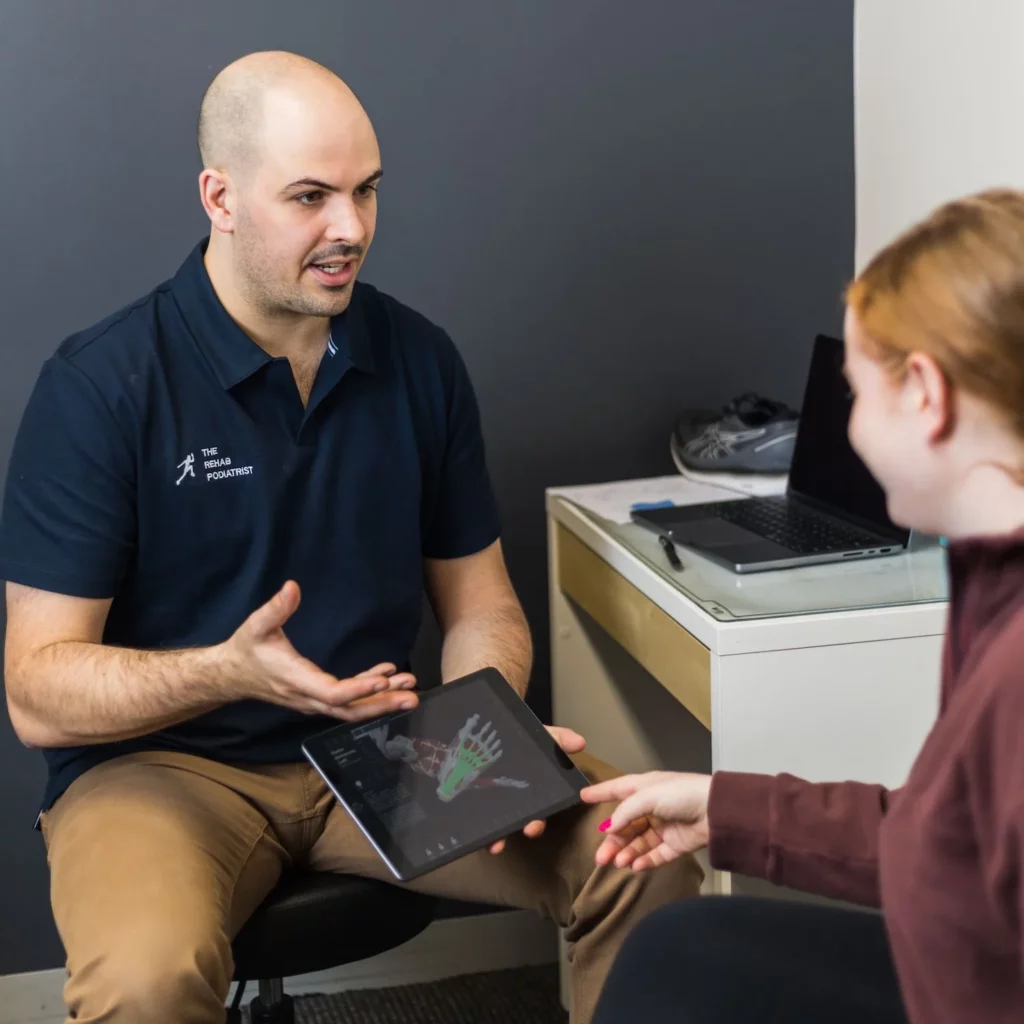Treatments
Common conditions I see
I treat all pain and injuries in the foot, ankle and shin. Common condition I see include:
Common Conditions
In Our Clinic
I diagnose and manage all musculoskeletal conditions (muscle, bone, joint, tendon ligament) of the foot, ankle and shin.
Common conditions I see (and you can click to find out more) are:

Other conditions I treat:
- All pain and injuries to the foot, ankle and shin
- Knee cap pain
- Altered walking patterns
- Recurrent sports injuries
- Paediatric sports injuries
- Complex cases
- Condition pre and post-orthopaedic surgery
- Hypermobility / Ehlers Danlos Syndrome
- Rheumatological conditions
- Ingrown toenails
- Low risk diabetes
- Corns/callouses

How I can help you
I offer a range of different services to help identify and manage your foot, ankle and shin pain. These include:
Podiatry FAQs
What is podiatry?
In Australia, Podiatry is a field of allied health focused on the treatment of all conditions of the foot and ankle.
This includes pain and injury to foot and ankle, conditions related to muscles, tendons, joints, ligaments, nerves and bones, skin and nail conditions, biomechanical and gait analysis (analysing how the lower limb moves, walks and runs), dermatological conditions, diabetes, wounds to the foot and ankle and autoimmune conditions such as rheumatoid arthritis.
Podiatry is also concerned with conditions of the whole lower limb (leg, knee, shin, hip and low back), where gait (walking/running), may be contributing to the condition, or where altering movement of the foot and ankle would help reduce symptoms. For example, knee-cap pain and buttock pain.
What is a podiatrist?
What does a podiatrist do?
A Podiatrist can assess, diagnose, and treat all conditions of the foot and ankle.
They have a range of assessments/tools they can use to help them diagnose a condition.
These include:
- A physical examination of the foot and ankle
- Visual analysis of a patient walking / running
- A biomechanical assessment of the whole lower limb – tests to figure out how the foot, ankle, leg, knee and hip move
- Blood flow (vascular) testing
- Sensation (neurological) testing
A Podiatrist can provide a range of specific services and treatments for the foot and ankle.
These include:
- Diagnosis of all foot and ankle conditions
- Foot orthotics, including completely customised devices made by taking a mould of a patient’s foot or premade orthotics
- Modify orthotics to change their function
- Repair of damaged or worn orthotics
- Provide footwear advice and prescription for specific sport/athletic footwear.
- Foot and ankle exercises
- Refer for imaging of the foot and ankle, e.g. x-ray, ultrasound, MRI etc.
- Provide medical nail care for those who have difficulty reaching their feet or have conditions such as diabetes that put them at high risk of infection if done incorrectly
- Non-surgical and surgical management of ingrown toenails
- Injection of local anaesthetics
- Removal of corns and callous (hard dead skin on the feet)
- Wart treatment
- Taking a nail or skin sample for testing
- Fungal nail treatments
- Skin condition treatment and advice
- Diabetic foot assessment
- Treatment of foot and ankle wounds
A Podiatrist can also do further training to provide more services. In addition to all the standard Podiatrist skills Alex can also:
- Test a patient’s strength using specialised strength testing equipment
- Prescribe exercises for your leg, knee, and whole lower limb
- Prescribe a strength and conditioning program design to improve performance
- Provide a return to sport plan after suffering a foot and ankle injury
What can podiatrists treat?
A Podiatrist can treat all conditions affecting the foot and ankle using the services they’re trained to perform.
Common conditions a Podiatrist treat are:
- Plantar fasciitis (heel pain)
- Neuroma
- Bursitis e.g. forefoot, achilles
- Achilles tendon pain
- Ankle pain
- Midfoot pain
- Osteoarthritis
- Knee-cap pain
- Stress fractures
- Bunions
- Shin splints (medial tibial stress syndrome – MTSS)
- Ankle sprains
- Joint pain (synovitis)
- Sesamoid pain
- Stiffness in feet
- Hypermobile (flexible) feet
- Flatfeet
- High arched feet
- Corns
- Callous
- Fungal nail infections
- Warts
- Diabetes
What is chiropody?
Chiropody is the original name given to the field of treating and foot and ankle conditions.
Originally an unregulated profession in the 60’s and 70’s, it was primarily focused on the medicalised treatment of skin and nail conditions of the foot. Over the years, it became a regulated profession and with the increased skills and experience, became known as the field of Podiatry.
Depending on the country, the term may still be used interchangeably with Podiatry, but in Australia it is generally used to refer to its original focus; the treatment of skin and nail conditions. This is compared with the larger scope the field of Podiatry has, despite the field requiring the same training as Podiatry up until it was completely replaced in the early 90’s with that label.
What is a chiropodist?
What does a chiropodist do?
What is the difference between podiatry and chiropody?
What is the difference between a chiropodist and a podiatrist?
Is a podiatrist or chiropodist a doctor?
In Australia, a Podiatrist or Chiropodist aren’t trained medical practitioners and are not a medical specialty. In other countries like the United States, Podiatry is a medical specialty, requiring more training and affording the title Doctor. They are able to provide more services, such as foot and ankle surgery.
Podiatrists and Chriopodists in Australia can use the title doctor, but it must be made clear when used they aren’t a medical practitioner to avoid confusion. Because of this, most Podiatrists don’t use the title.
Can a podiatrist or chiropodist help with ingrown toenails, calluses, bunions, foot fungus, corns, or diabetic feet?
How much does podiatry consultation & treatment cost?
The cost of an appointment depends on the practitioner and the specific service.
At The Rehab Podiatrist, we have three different types of appointments.
- For diagnosis and treatment of foot and ankle pain/injuries (muscles, tendons, ligaments, nerves, joints etc.)
- For diagnosis and treatment of nail and skin conditions
- For diabetic foot assessment, treatment and advice
There are also different costs if this is the first time you’ve seen the clinic for this issue, or a subsequent visit.
For foot and ankle pain/injuries
Initial appointment (1 Hour) – $230
Subsequent appointment (30 min) – $120
For nail and skin conditions
Initial appointment (30 min) – $130
Subsequent appointment (30 min) – $120
For diabetic foot assessment
Initial (30 min) – $150
Subsequent appointment (30 min) – $140
There are also other costs for specific services such as foot orthotics and ingrown toenail surgery.
You can find the fee’s located on our webpage here.
What my patients are saying
Lauren L2024-01-12Alex is an excellent and knowledgeable podiatrist and a warm and caring person. I've been to many health practitioners and Alex is a clear standout. He has expertise as a podiatrist and also considers the body holistically, which was crucial in my progress and reducing pain. His service goes above and beyond - I cannot recommend him highly enough!Kenneth Menz2023-12-01I was very happy with my visit to Alex yesterday. My situation was somewhat complex and we spent a considerable time analysing the various aspects of it. I was impressed with his caring manner and his insights. Price was a little higher than some, but we spent a whole hour - no scrimping on time. There was no pressure placed upon me for a return visit. (One particular major Canberra podiatry chain seems to be more driven by encouraging return visits than they are by providing solutions). I will return to Alex if I feel the need, and I am interested now to see how his suggestions play out.Jen2023-11-17Alex has been a fantastic help and gone out of his way to help me figure out what's been causing my ankle pain, highly HIGHLY recommend using him, very knowledgeable and personablePatrick Doan2023-11-09Alex is a very knowledgeable clinician. As another Podiatrist myself, I have worked with him professionally and it is clear that he is passionate in his work clinically and as an educator. There are very few sports podiatrists in Australia that understand the importance and process of foot and ankle rehabilitation. He also clearly enjoys helping people of all ages and abilities get back to sport and physical activity.Chris Richardson2023-03-21Great experience with Alex 😄 Complex sprained ankle. Excellent treatment. Even better, matched with very good explanations of what was going on and why 👍 Highly recommended.Joanna Richards2023-03-19Cannot recommend enough! I visited Alex after having a recurring pain in my foot which was totally limiting my ability to live my life. As someone who works on my feet and exercises daily, the pain was stressing me out. Alex was extremely thorough. I really felt like he took his time to fully understood what was going on. He sent me home with a comprehensive plan of attack. Not only did he give me rehab exercises and stretches, he gave me advice on how to adjust my daily movements to reduce my pain and he made some custom orthotics for both my runners and my favourite shoes. Pain went away within a few days. If you have an issue, go see Alex immediately. No hesitation in recommending him.Simon Lewis2023-03-11Very knowledgeable on all things feet and rehab. He is my go to when I have a patient with a complex foot injury.Geoffrey Ford2023-03-10Alex was by far the best podiatrist I have been to. He was incredibly friendly and welcoming and didn’t try to force his plan on me but instead worked with me to help me get back to my goals. I’ve found other therapists often just try and sell you on their plans. Thanks for your help Alex, my feet feel so much better and I’m no longer worried about them.Ryan L. McGrath2023-03-10Alex is an extremely knowledgeable, passionate, and caring clinician. I have collaborated with Alex on a research article on plantar heel pain management, and during this process, it was clear that his expertise regarding lower foot, ankle, and leg pain is second to none. His passion for achieving the best outcomes is evident in his commitment to staying up-to-date on the latest developments in rehabilitation and pain management.
